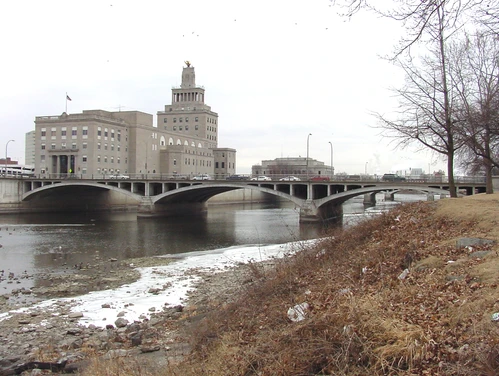- Year constructed: 1920
- Alternate name: Cedar River Bridge
- Bridge type: Concrete Open Spandrel Arch
- National Register of Historic Places status: Listed
- Length: 697 feet
- Width: 80 feet
- Spans: 6
- FHWA: 033490
- Jurisdiction: Iowa DOT
- Location: U.S. 151 (First Avenue) over the Cedar River in Cedar Rapids; Section 28, T83N-R7W (Rapids Township)
Details
The First Avenue Bridge spans Cedar River in downtown Cedar Rapids in the southern section of Linn County. According to historical markers at each end of the structure, this structure was built in 1920 for $420,000 by the Des Moines-based Koss Construction Company, from plans drawn up by the Marsh Engineering Company. In its original form, the bridge was a six-span, concrete arch with solid masonry spandrel walls and balustered stone guardrails. In the early 1960s, owing to the bridge's deteriorating condition, city officials commissioned consulting engineer Ned L. Ashton of Iowa City to reconstruct the arch for modern traffic loads. Ashton's remodeling plan called for demolishing all concrete work above the original arches and rebuilding the bridge as an open-spandrel structure with a wider deck and aluminum railings. Completed at a cost of $290,000 by the Cramer and Bayse Company and the Des Moines Bridge Company, this rehabilitation significantly altered the bridge's historic character. The bridge continues to carry relatively heavy urban traffic.
Ned Ashton is remembered as Iowa's most distinguished bridge engineer who helped pioneer bridge reconstruction with this project. The original 697-foot arch had almost reached a state of condemnation because of crumbling concrete. The spans were hollow and clay-filled, and ill- designed to carry excessive weight. Ashton believed the foundations and arches could be rebuilt, saving the city a significant amount of money while producing a more modern, stronger bridge. The Cedar Rapids Gazette reported that "Ashton described the bridge as the only one of its type in the country." Ashton explained that this was the only arch-type bridge to be rebuilt from the arches up. He felt it was "one of the most beautiful (bridges) I have ever had the privilege of working on." Ashton's innovative hinged cross-rib design distributed the weight more evenly, allowing the bridge to breathe. The success of the First Avenue rehabilitation was the catalyst for all of Cedar Rapids' circa 1910 and 1920 spandrel arches to be rebuilt in the same manner. The city-wide project subsequently convinced other cities to consider rebuilding their own aging bridges instead of simply tearing them down and erecting new structures. Although the First Avenue Bridge's structural integrity has been disturbed, Ashton was able to save the original foundations and arches, which is preferable to losing the entire bridge. Therefore, the Cedar River Bridge has gained new historical importance as the first notable concrete spandrel arch reconstruction in Iowa and possible in the United States, and for its association with the renowned Iowa bridge engineer, Ned Ashton.
Adapted from Hess and Crow-Dolby 1992
Areas Served
- Linn
